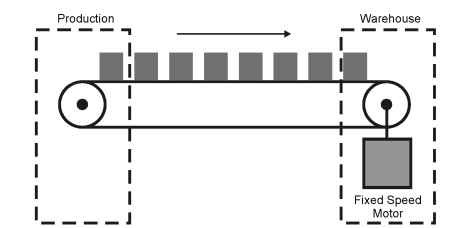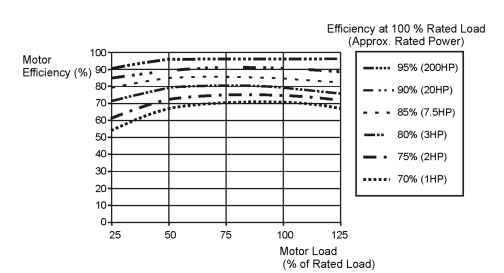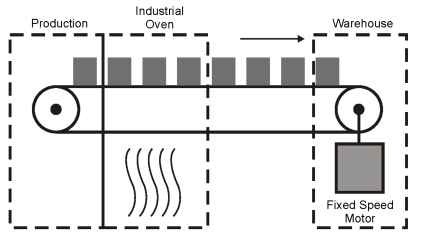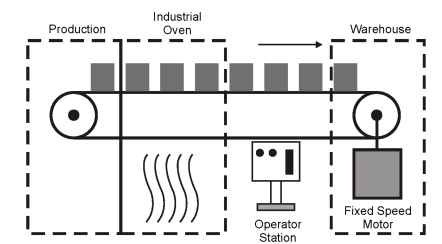In the most generic sense, a drive is a device that controls speed, torque, direction, and the resulting horsepower of a system. There are many different types of drives, and they will be discussed later in this topic. For now, we will focus on the reasons for drive use in our industrial and commercial environments. To appreciate the use and benefits of any type of drive, we need to look at a generic application and determine how the system could be improved.
Figure 1-1 shows a prime candidate for a variable-speed drive—a conveyor in a manufacturing plant.

Figure 1-1. Generic conveyor system
In Figure 1-1, we can see that the conveyor’s main intent is to move products from production to the warehouse. A typical way to move products is by means of a motor. The generic motor on this conveyor operates at only one speed. With only one speed of motion, this type of manufacturing system has its drawbacks.
The products can reach the warehouse only in a given timeframe. There is no way to gradually increase the conveyor speed. If it takes the motor a very short time to accelerate, the boxes may fall off the conveyor because of the accelerating forces. We will look at several factors that lead to the use of a variable-speed drive: efficiency gains, process changes and improvements, and system coordination.
Efficiency Gains
We may view the system in Figure 1-1 as very inefficient. We are locked into whatever efficiencies the motor can provide, given a somewhat variable amount of loading. If the motor in Figure 1-1 happened to be an alternating current (AC) motor, typically, the following would be true:
1. The more load on a motor, the more efficient that motor is.
2. The higher the motor’s horsepower (HP) rating, the higher the efficiency.
3. The higher the operating speed, the more efficient the motor.
We will cover the physical makeup of AC and direct current (DC) motors in more detail in topic 3. For now, we will use an AC motor to explain the effects of efficiency on the total system.
As seen in Figure 1-2, efficiencies vary as indicated above.

Figure 1-2. Typical AC motor efficiencies
If the conveyor motor happened to be 1 HP, we may expect to see only 70% efficiency, at 75-100% motor load. (% Efficiency = output power -f-input power x 100). By strict definition, the 1-HP AC conveyor motor would be operating at a 30% loss at 75-100% motor load.
Figure 1-3 indicates AC drive and motor efficiencies at various speeds.

Figure 1-3. AC drive and motor efficiencies
Figure 1-3 shows an example of a 2-HP system. In this example, if we added a variable-speed AC drive, our efficiency of this constant torque (CT) system would be in the range of 80-90% when the conveyor is operated at 60% speed or higher. A conveyor is labeled a constant torque load and is indicated by a CT on the graphs.
It should be noted that the AC drive is an efficient means of varying the speed of an AC motor. Its 5-10% losses are attributed to thermal losses because of the alternating current’s switching of power devices several thousand times per second. Variable-speed output from a drive has a direct impact on the total system efficiency. A manufacturer can operate the production equipment at the most efficient speed and load point—if drive and motor efficiencies are known.
Process Changes and Improvements
As previously indicated, in a fixed system there is no way to vary the speed of the conveyor. A fixed system will not allow for changes in the process or production cycle. Some manufacturing circumstances may require a slow speed, others, a faster pace.
The same conveyor system is used in processes such as baking. Figure 1-4 illustrates the same type of conveyor, with the addition of an industrial oven.
Certain materials may require a longer baking cycle because of thickness. If a fixed-speed motor is used, only one type of material could be processed in this system. To stay competitive, many companies require flexibility in manufacturing. A variable-speed system is often necessary to change production cycle times and increase capacity.

Figure 1-4. Industrial oven used in production
System Coordination
The system shown in Figure 1-4 is typical of many manually operated processes. An operator turns on the system and turns it off for maintenance or at the completion of the production cycle. However, in an age of increased flexibility requirements, few processes are manually operated. Production cycles are constantly monitored by some type of computer system.
Computer systems will automatically oversee the process and correct for load fluctuations, material density, and size requirements. In industrial processes, the use of PLCs (programmable logic controllers) is typical. Programmable logic controllers are beyond the scope of this topic, but will be addressed at various points. Figure 1-5 illustrates a conveyor system that is manually operated by a control station.

Figure 1-5. Manually controlled conveyor system
Programmable logic controllers work effectively in place of the manually controlled operator station. Automatic control of the motor could therefore be accomplished, but only STOP and START control, in this case. Variable-speed drives would be effective in providing the flexibility and control needed by motors to meet almost any application requirements.
